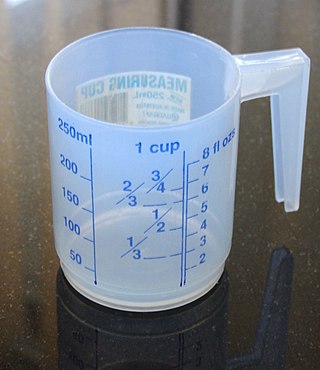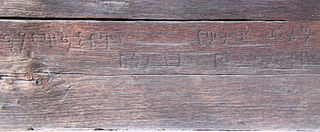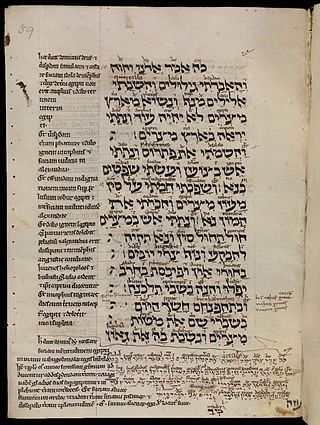
Volume is a measure of regions in three-dimensional space. It is often quantified numerically using SI derived units or by various imperial or US customary units. The definition of length (cubed) is interrelated with volume. The volume of a container is generally understood to be the capacity of the container; i.e., the amount of fluid that the container could hold, rather than the amount of space the container itself displaces. By metonymy, the term "volume" sometimes is used to refer to the corresponding region.
Biblical and Talmudic units of measurement were used primarily by ancient Israelites and appear frequently within the Hebrew Bible as well as in later rabbinic writings, such as the Mishnah and Talmud. These units of measurement continue to be used in functions regulating Jewish contemporary life. The specificity of some of the units used and which are encompassed under these systems of measurement have given rise, in some instances, to disputes, owing to the discontinuation of their Hebrew names and their replacement by other names in modern usage.

The cubit is an ancient unit of length based on the distance from the elbow to the tip of the middle finger. It was primarily associated with the Sumerians, Egyptians, and Israelites. The term cubit is found in the Bible regarding Noah's Ark, the Ark of the Covenant, the Tabernacle, and Solomon's Temple. The common cubit was divided into 6 palms × 4 fingers = 24 digits. Royal cubits added a palm for 7 palms × 4 fingers = 28 digits. These lengths typically ranged from 44.4 to 52.92 cm, with an ancient Roman cubit being as long as 120 cm.

The foot is a unit of length in the British imperial and United States customary systems of measurement. The prime symbol, ′, is commonly used to represent the foot. In both customary and imperial units, one foot comprises 12 inches, and one yard comprises three feet. Since an international agreement in 1959, the foot is defined as equal to exactly 0.3048 meters.

The hand is a non-SI unit of measurement of length standardized to 4 in (101.6 mm). It is used to measure the height of horses in many English-speaking countries, including Australia, Canada, the Republic of Ireland, the United Kingdom, and the United States. It was originally based on the breadth of a human hand. The adoption of the international inch in 1959 allowed for a standardized imperial form and a metric conversion. It may be abbreviated to "h" or "hh". Although measurements between whole hands are usually expressed in what appears to be decimal format, the subdivision of the hand is not decimal but is in base 4, so subdivisions after the radix point are in quarters of a hand, which are inches. Thus, 62 inches is fifteen and a half hands, or 15.2 hh.

A span is the distance measured by a human hand, from the tip of the thumb to the tip of the little finger. In ancient times, a span was considered to be half a cubit. Sometimes the distinction is made between the great span or full span and little span or short span.
The megalithic yard is a hypothetical ancient unit of length equal to about 2.72 feet (0.83 m). Some researchers believe it was used in the construction of megalithic structures. The proposal was made by Alexander Thom as a result of his surveys of 600 megalithic sites in England, Scotland, Wales and Brittany. Thom also proposed the megalithic rod of 2.5 megalithic yards, or on average across sites 6.77625 feet. As subunits of these, he further proposed the megalithic inch of 2.073 centimetres (0.816 in), one hundred of which are included in a megalithic rod, and forty of which composed a megalithic yard. Thom applied the statistical lumped variance test of J.R. Broadbent on this quantum and found the results significant, while others have challenged his statistical analysis and suggested that Thom's evidence can be explained in other ways, for instance that the supposed megalithic yard is in fact the average length of a pace.

The digit or finger is an ancient and obsolete non-SI unit of measurement of length. It was originally based on the breadth of a human finger. It was a fundamental unit of length in the Ancient Egyptian, Mesopotamian, Hebrew, Ancient Greek and Roman systems of measurement.
The ancient Egyptian units of measurement are those used by the dynasties of ancient Egypt prior to its incorporation in the Roman Empire and general adoption of Roman, Greek, and Byzantine units of measurement. The units of length seem to have originally been anthropic, based on various parts of the human body, although these were standardized using cubit rods, strands of rope, and official measures maintained at some temples.

The ancient Roman units of measurement were primarily founded on the Hellenic system, which in turn was influenced by the Egyptian and the Mesopotamian systems. The Roman units were comparatively consistent and well documented.

The measures of the old Romanian system varied greatly not only between the three Romanian states, but sometimes also inside the same country. The origin of some of the measures are the Latin, Slavic, Greek and Turkish systems.

The earliest recorded systems of weights and measures originate in the 3rd or 4th millennium BC. Even the very earliest civilizations needed measurement for purposes of agriculture, construction and trade. Early standard units might only have applied to a single community or small region, with every area developing its own standards for lengths, areas, volumes and masses. Often such systems were closely tied to one field of use, so that volume measures used, for example, for dry grains were unrelated to those for liquids, with neither bearing any particular relationship to units of length used for measuring cloth or land. With development of manufacturing technologies, and the growing importance of trade between communities and ultimately across the Earth, standardized weights and measures became critical. Starting in the 18th century, modernized, simplified and uniform systems of weights and measures were developed, with the fundamental units defined by ever more precise methods in the science of metrology. The discovery and application of electricity was one factor motivating the development of standardized internationally applicable units.
There are a number of Spanish units of measurement of length or area that are virtually obsolete due to metrication. They include the vara, the cordel, the league and the labor. The units of area used to express the area of land are still encountered in some transactions in land today.
Dimensional metrology, also known as industrial metrology, is the application of metrology for quantifying the physical size, form (shape), characteristics, and relational distance from any given feature.

A measuring rod is a tool used to physically measure lengths and survey areas of various sizes. Most measuring rods are round or square sectioned; however, they can also be flat boards. Some have markings at regular intervals. It is likely that the measuring rod was used before the line, chain or steel tapes used in modern measurement.

Egyptian geometry refers to geometry as it was developed and used in Ancient Egypt. Their geometry was a necessary outgrowth of surveying to preserve the layout and ownership of farmland, which was flooded annually by the Nile river.

Byzantine units of measurement were a combination and modification of the ancient Greek and Roman units of measurement used in the Byzantine Empire.

Ezekiel 40 is the fortieth chapter of the Book of Ezekiel in the Hebrew Bible or the Old Testament of the Christian Bible. This book contains the prophecies attributed to the prophet/priest Ezekiel, and is one of the Books of the Prophets. The Jerusalem Bible refers to the final section of Ezekiel, chapters 40-48, as "the Torah of Ezekiel". This chapter describes Ezekiel's vision of a future Temple.














